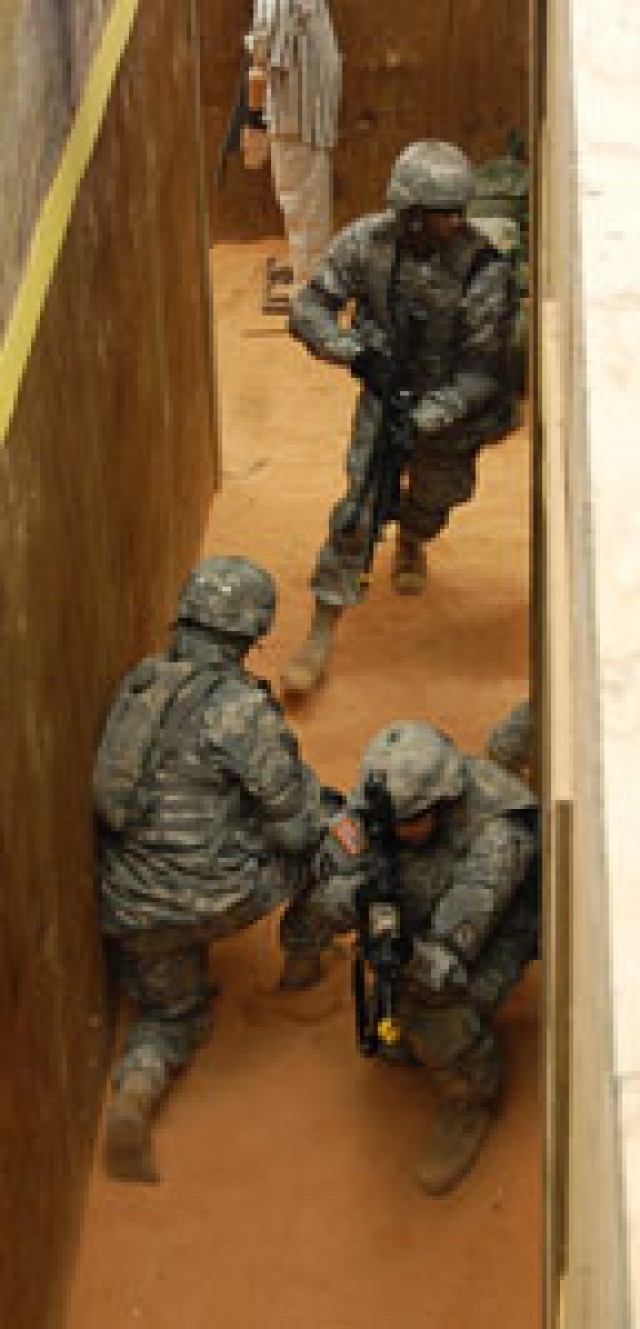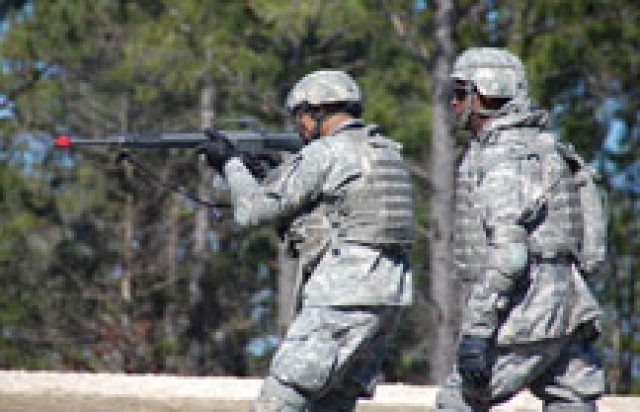FORT POLK, La. -- If the old adage "Experience is the best teacher" is correct, then the 48th Chemical Brigade has selected a top-notch unit to train its company commanders and first sergeants in the finer points of movement on today's battlefield.
Fort Polk's 7th Chemical Company, 83rd Chemical Battalion, 48th Chem Bde, will provide instruction to the 48th Chem Bde leaders next week at Fort Polk's Peason Ridge training area. As a tune up to the big event, 7th Chem Co taught 83rd Chem Bn staff members assigned to Headquarters and Headquarters Detachment how to clear a building and move with a battle buddy under fire at Peason Ridge's Digital Multi-Purpose Battle Area Complex Feb. 9.
"We have the most experience (in the brigade) in running this type of exercise," said 1st Lt. Heather Morgan, executive officer, 7th Chem Co. "Not only have we done this type of training ourselves, we've also conducted 'train-the-trainer' instruction for our battalion."
Capt. Rogelio Pineda, commander, 7th Chem Co, said chemical units from across the United States, including New York, Fort Lewis, Wash., Fort Hood, Texas, and Ft. Bragg, N.C., will arrive at Fort Polk next week for the training.
"We were chosen not only for our experience in protective force training, but also because of the excellent facilities we have at Fort Polk and Peason Ridge," Pineda said. "At most installations, chemical companies find it difficult to get time on resources such as those at Peason Ridge. We've got a great relationship with range control and have the finest resources in the Army inventory."
As far as the training provided to HHD Feb. 9, Pineda said not only was it good practice for the brigade exercise, it also provided much-needed training for the unit's Soldiers.
"HHD has so many other areas to worry about and it's difficult for them to conduct their own training," he said. "For them not to have to worry about running the range is important."
Capt. Rochelle Sallis, commander, HHD, agreed.
"This is a great opportunity for our unit to get out of the office and into the fight," Sallis said.
"Nowadays, you can find yourself in any type of situation on the battlefield. If we were to deploy without the companies we typically support, we could be pulling any type of mission, so this training is very important."
Sallis pointed to another benefit of the training.
"Our Soldiers won't always be in an HHD-type unit," she said. "It's important we keep up our Soldiering skills."
Staff Sgt. Dwon Chavis, 7th Chem Co, was one of the instructors at Peason Ridge. He said regardless of a Soldier's military occupational specialty, they are first of all an infantry Soldier.
"It doesn't matter what your MOS is, when you're in combat, you have to be able to protect yourself, your equipment and your fellow Soldiers," Chavis said.
To ensure HHD Soldiers and the rest of the brigade received the full benefit of training, Chavis said trainers used the "crawl, walk, run method."
"We'll walk them through the exercise first, then we'll take them through with blanks, and finally we'll go with live fire," he said. "By the time we're finished, they should be proficient."
Sgt. John Carroll, 7th Chem Co, was also part of the instructional team. He said Soldiers assigned to chemical units could expect to be assigned a wide variety of jobs during deployments to combat areas.
"When we go to Iraq or Afghanistan, we might be called on to clear a room or provide convoy support," Carroll said.
"This type of training provides the basics for these types of operations. That's why it's important that we stay sharp with our combat skills."
After the training was complete, Sallis reflected on her unit's training.
"I can't remember the last time we did a live fire exercise, except for our annual marksmanship training," she said. "We were able to move out, acquire a target, then engage the target."
Sallis identified what she said was one of the most important aspects of the training.
"As a result of this training, our Soldiers have increased confidence not only in their own ability to react under fire, but also to their buddy's ability to react," she said. "It was a great team building exercise and made us better prepared to go to war."




Social Sharing